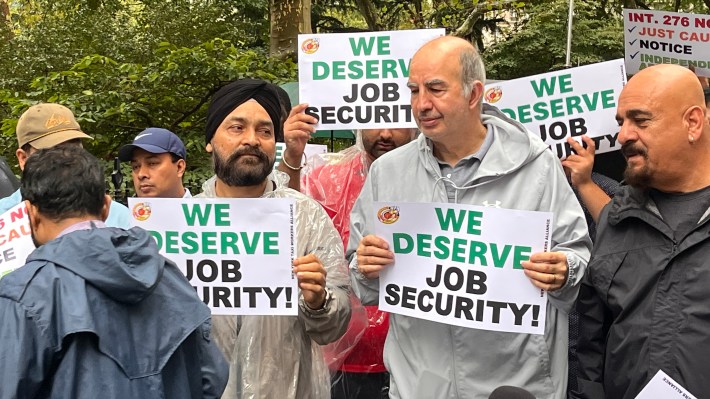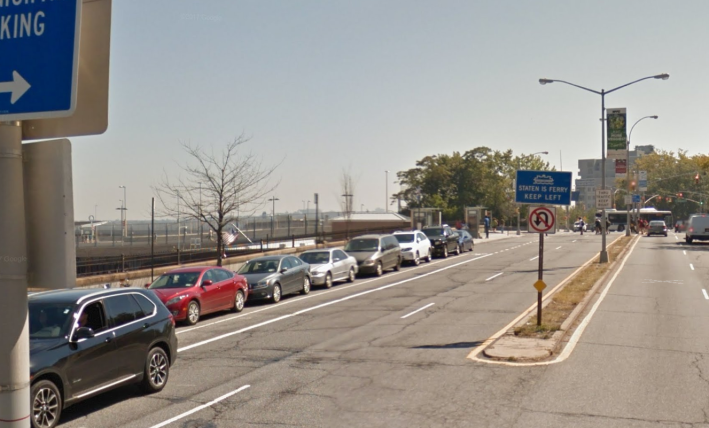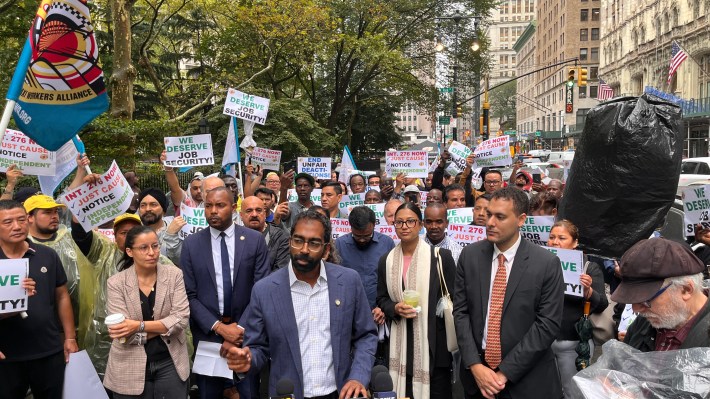Kinley Ragbey was making a routine pickup on Staten Island. The longtime Uber driver was piloting his 2018 Mazda near the borough's iconic ferry terminal when the disembodied drawl of Uber’s navigation system told him, “Make a U-turn to stay on Richmond Terrace, then pick up Ariane.”
But just as he approached the suggested U-turn, he received a very different, very physical, command from a different authority: a city-installed "No U-turn" sign.
But Ragbey did what Uber instructed: he ignored the city sign and followed the company's directions to make the illegal U-turn — and in the process, hit a man traveling the opposite direction on his electric scooter, launching him into a parked car and causing serious injuries that later required multiple surgeries.
Now that man, John Tsang, is suing both Ragbey and Uber for damages stemming from a crash that caused multiple fractured vertebrae. The devastating crash, and the testimony from Ragbey in the ongoing lawsuit, highlight the pervasive ride share app’s most troubling contradiction.
“[Uber] feeds an illegal routing instruction to both passenger and driver to cut corners and get the driver to the passenger faster, because that's how Uber wins,” said Steve Vaccaro, a bike lawyer and safe streets advocate who is representing Tsang in the case. "[Uber] is trying to [say] everything was [the driver’s] choice and his judgment as to what to do and how to do it. But in fact, [Uber] has set up this game of driver versus passenger, where Uber always wins."
Uber told Streetsblog that it doesn't comment on ongoing litigation but that the company, "take[s] road safety, and the safety of all riders and drivers seriously."
'I did it because my Uber said to'
Uber drivers feel obligated to follow the in-Uber navigation to pick up a passenger because their customers are watching the gig-worker chauffeurs approaching the pickup spot in real time, on a map in the Uber app. If drivers stray from the path, customers are likely to complain or cancel, which can lead to penalties and even deactivation from the app — effectively a termination. When Uber drivers sign up, they have the option to select navigation from Uber, Waze, or Google, but whichever they choose stays within the Uber app. Ragbey chose Uber, and most other drivers told Streetsblog that they do, too.
“When I drive Uber, since it's connected to the Uber company, I always follow the Uber apps [because] I'm concerned about the complaints from the passengers as well,” Ragbey said when questioned in court by Vaccaro about the Staten Island crash.
Uber's testimony in the lawsuit makes clear the company's position: Ragbey is an independent contractor — like all the company's drivers. The company would not elaborate on how it creates its in-app navigation system and said drivers are not forced to use it.
“Uber may provide ... a suggested route based on our technology's most-current and up-to-date information about the roadways at that time. But folks on the driver version of the Uber app are expected to follow any and all posted signs,” Benjamin Carroll from Uber’s operations team told Vaccaro in a deposition.
But to Ragbey, using the Uber app to pick up Ariane was required.
"To pick up passengers using Uber app is a must and the Uber app gives correct location," he said of making the U-turn before hitting Tsang. "I did it because my Uber said to."
Fears fuel danger
Ragbey’s testimony is an example of a larger trend, where Uber and Lyft drivers are in such fear of getting kicked off the app that their judgment is clouded and they end up driving in an unsafe manner in a desperate bid to retain their job.
The threat of deactivation looms large for the more than 80,000 Taxi and Limousine Commission licensed drivers that work for both Uber and Lyft. Driving for an app becomes a nightmare where one's livelihood can be lost in the blink of an eye.
"The unfair deactivation of taxi drivers is the single biggest issue that drivers face in the city. When they lose their livelihood, they lose their ability to pay their rent, to pay their mortgage, to pay their childcare, to support their families, and simply live in this city," said Council Member Shekar Krishnan at a 2024 hearing for his bill that seeks to make the system more fair for drivers.
It is common to be deactivated if an Uber passenger accuses the driver of using his phone while driving, even though the app is the primary way in which a driver finds and picks up the passengers and navigates the city in an efficient manner.
"With a mounted phone .. you get the next ride before the ride is finished. You have to interact with your phone," Walter Hurdle, an Uber driver with six years on the job before his account was deactivated, testified at the Council hearing. "I got an email from Uber. 'A customer said you were using your phone,' they said. Any allegations of this nature can result in removal from the Uber platform."
Drivers tell story after story of living in fear of any conflict with passengers. Once a customer makes a complaint, drivers say there is little they can do to rectify the situation, even if they didn't do anything wrong.
"It's not easy dealing with passengers who lie and say different things about drivers like myself and others who are working so hard," another Uber driver, Dennis Addison, testified. "Uber listens to these passengers who get free rides because of what they say. They don't even take into consideration us, the drivers. We are completely mute. We have no say, no comment whatsoever."
What is an 'Uber driver'?
Uber argues in the ongoing lawsuit that not only was Ragbey expected to use his own judgment over Uber's mechanical orders, but, more importantly, he is not actually an “Uber driver” at all because the $200-billion company merely considers people like Ragbey private contractors who provide a service to customers.
In other words, to Uber, there is no such thing as an Uber driver.
Throughout Ragbey’s testimony, when Vaccaro referred to him as an “Uber driver,” the company's lawyers would object.
Later, Vaccaro asked Carroll about the moment when Ragbey called Uber after he hit Tsang and asked the company for advice. The Uber representative asked Ragbey if he was “working for Uber” at the time of the crash.
“Did you hear the Uber representative characterize Mr. Ragbey as working for Uber at the time that he was on his way to pick up a passenger?” asked Vaccaro.
“Yes. I heard him use that colloquialism,” Carroll replied. “That's not something that we would say typically here at Uber, though.”
Vaccaro pressed, asking what he would call Ragbey.
“I don't know, but it would be something in line with reality, which is that this person is working for themselves,” said Carroll.
Uber goes to great lengths to prove in court that these drivers, who work full days for the company and risk deactivation, are not actually employees and therefore are solely liable for a crash like the one on Staten Island.
Employment law experts say this is all part of the playbook that has allowed Uber to become dominant yet assume little liability.
“If [Uber] says it enough times and stonewalls the legal process effectively enough, it becomes true,” said Dan Ocampo, an attorney with the National Employment Law Project. “Even if, to any reasonable observer, it's obviously nonsense. I think that's been a big part of their success.”
And on top of that, Uber drivers are unable to fight in court, since all drivers must agree to a “forced arbitration” clause as a condition of signing onto the Uber app. This means most cases are argued outside of court and that class-action lawsuits can't be brought.
This makes it almost impossible to know what an Uber driver actually is, and do they qualify as employees.
“[Uber] actually can't be sued by the driver on any kind of employment theory, because it's forced arbitration. So there's actually just no real way to resolve this question,” said Ocampo.

Since Tsang is the one suing Uber, the saga is playing out in public.
In other cases where Uber has been sued by a third party, the company stays insulated because of its reliance on private contractors instead of employees and there being no legal precedent to clearly define what an "Uber driver" actually is.
On New Year's Eve in 2013, 6-year-old Sofia Liu was killed by a driver in a San Francisco crosswalk. Lui’s family sued Uber as well as the driver, who was connected to the Uber app at the time. The driver, Hernan Pulla, testified that he was looking at "the Uber app's GPS with one eye and drove straight with his other eye,” when he hit Lui, according to court filings.
During those proceedings Uber made many of the same arguments it is still making 12 years later. The company claimed it could not be held liable for the actions of the driver because it was just a "technology company that uses its proprietary technology to develop and maintain digital and multi-sided marketplace platforms," in court filings.
And it worked. A judge ruled to dismiss the case against Uber saying Pulla “just as easily have been using any number of navigation apps at the time of the accident.” But in this instance, the company settled outside of court with the Lui family, essentially paying for the possibility of being held liable, if the settlement was not reached.
But in another recent case, which was decided by the same judge that is presiding over Tsang's case, Uber was let off the hook after a minor collision in Queens.
Lawyers for the passenger, Argentina Martinez, tried to argue that Uber knowingly "created an unsafe and hazardous monitoring distraction for its drivers," and that the company was liable and should be treated as the employer of the driver, Vladislav Teplinskiy.
But Judge Karina Alomar ruled in September that "Uber drivers are not employees but rather independent contractors."
The decision is significant because it clarifies that Uber is not an employer of its drivers and therefore cannot be held liable for their actions.
Dangerous, opaque algorithms
The “No U-turn” sign has been up since at least 2015, according to archival photos. As such, Vaccaro remains outraged that Uber's navigation system is either unaware of the sign or blatantly ignoring it.
"Uber is saying, ‘No, it's all on the driver to exercise their independent judgment.’ Well, wait a minute, you haven't shown us how the app showed a permissible U-turn in that area, and you haven't given us a discovery to determine whether or not you knew that ‘No U-turn’ sign was there,” he said.

Vaccaro is trying to get the company to reveal its algorithm to answer this question, but Uber initially argued that that would be a violation of the company’s trade secrets.
To experts, the algorithm behind the illegal instruction is key to understanding the case, and Uber’s liability.
“Uber's business, which causes thousands of motor vehicle operators to drive while receiving audible and visual instructions through an app-based routing engine, should include reasonable steps to quality-test routing data and instructions and to train drivers to be prepared to disregard instructions to make illegal turns,” Evan Korth, computer science professor at New York University, wrote in an affidavit arguing for Uber to be forced to come to the table.
“It is impossible to determine whether Uber has taken such steps without further information concerning the coding and development of the Uber app routing engine of the type sought in Tsang's discovery requests.”
Uber still hasn't revealed the nuts and bolts of how Ragbey was ordered by the app to make the illegal turn, the parties in the lawsuit are currently negotiating the terms of a protective order, which could take months.
Pushing for reform
Krishnan's bill, Intro 276, would give Uber and Lyft drivers “just cause” protections – meaning they cannot be deactivated without a clear reason and an independent appeals process.
Uber drivers frequently testify that pressure from the company impacts their decision-making process while driving. Drivers say the threat of deactivation is made worse by the lack of a fair, impartial review process.

“The customer can always complain and say, ‘Why are you detouring?’ but it’s not that I’m detouring. I'm just following the right way to drive,” said Oudit Beharry at a rally in support of Krishnan’s bill.
Beharry has been driving for Uber for around six years but has spent 35 years behind the wheel as a limousine driver. He said that the pressure of deactivation is "terrible" and that all Uber drivers use the in-app directions for fear of conflict with passengers.
“The app is terrible and the algorithm controls you. When they give you a ride, they will say, 'two minutes,' but actually it's five minutes. By the time you get there, passengers can be upset. It’s beyond control,” said Beharry.
Bhairavi Desai, the executive director of the New York Taxi Workers Alliance, added that their status as independent contractors means that drivers aren't working for anyone — or, are, in fact, working for everyone.
“What Uber and Lyft have essentially done is turned every single person in the back seat into your direct supervisor, along with the algorithm on the app itself,” said Desai, whose union represents Uber, Lyft, yellow and black car drivers.
"The bill will give drivers the assurance that there will be due process. They won't have to work under the same pressures and succumb to illegal turns the app might want them to make."
The bill, which has 18 sponsors, was heard by the Council last September, but has yet to be brought to a vote.






